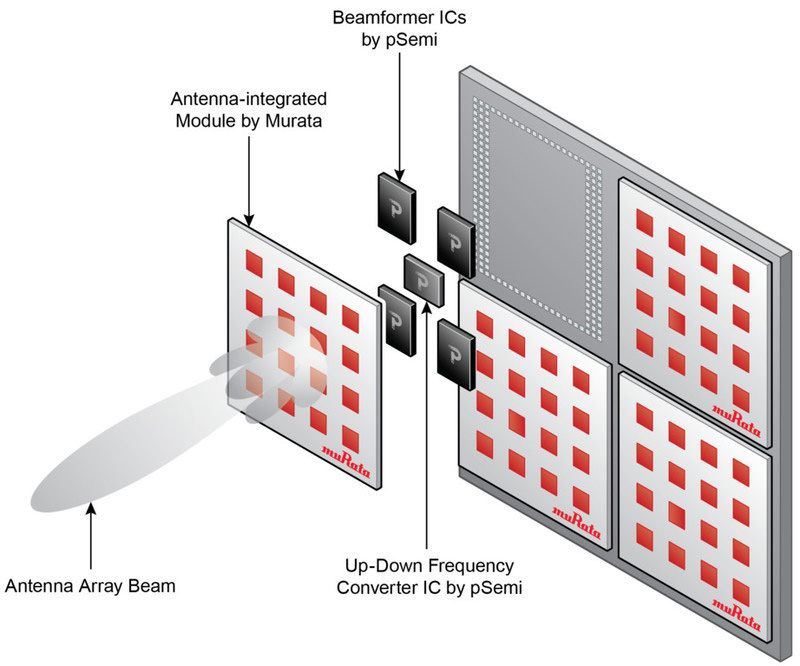News: Microelectronics
2 February 2022
pSemi introduces complete 5G mmWave RF front-end solution
Murata company pSemi Corp of San Diego, CA, USA – a fabless provider of radio-frequency integrated circuits (RFICs) based on silicon-on-insulator (SOI) – has announced the expansion of its millimeter-wave (mmWave) RF front-end (RFFE) portfolio for 5G wireless infrastructure applications.
The new pin-to-pin compatible products, including three beam-forming ICs and two up-down converters, offer flexibility to interchange ICs for full IF-to-RF coverage across the n257, n258 and n260 bands. This modular approach, combined with on-chip calibration and digital correction, allows system teams to simplify their design cycles and quickly adapt to different active antenna design configurations. Available as discrete RFICs or as part of the Murata 28GHz antenna-integrated module, this diverse portfolio delivers performance, integration and reliability in the smallest IC form factor, it is claimed.

Picture: pSemi’s integrated portfolio of 5G mmWave products, which offers individual ICs as well as an antenna-integrated module.
mmWave will reach mainstream deployments first in dense urban areas that benefit from short-range coverage supported by smart repeaters, indoor base stations and other small-cell applications. This increased demand for network capacity, along with the proliferation of beam-forming and active antenna systems, has opened new doors for SOI-CMOS technology as the preferred mmWave platform for advanced 5G systems, says pSemi.
“pSemi has offered mmWave products since 2015, deepening our expertise and patent portfolio in high-frequency RF SOI design,” says Vikas Choudhary, VP of sales & marketing. “This history — combined with the advanced packaging and global manufacturing strength of our parent company, Murata — enables us to support higher levels of integration to simplify 5G mmWave development and deployment,” he adds.
8-channel beam-former RFIC features and benefits
Each PE188100, PE188200 and PE189100 RFIC integrates power amplifiers (PA), low-noise amplifiers (LNA), phase shifters and switches into a single die that provides optimal signal strength for up to 1024-element antenna arrays.
- Full spectrum coverage – n257 (PE188200), n258 (PE188100) and n260 (PE189100) band support and pin-to-pin compatibility.
- Flexible antenna design – Eight independently controllable RF channels with support for four dual-polarized or eight single-polarity antenna elements.
- Beam-forming accuracy – Linear POUT at the desired EVM with low RMS phase and amplitude error for increased array gain and antenna directivity.
Dual-channel up-down converter RFIC features and benefits
Each PE128300 and PE129100 RFIC integrates frequency multipliers, quadrature mixers, amplifiers and switches into a single die that can be paired with up to 16 pSemi beam-forming RFICs, or 128 total beam-former channels, to support massive MIMO, hybrid-beam-forming and other active antenna configurations.
- Wideband coverage – n257/n258 (PE128300) and n260 (PE129100) band support and pin-to-pin compatibility.
- Low-noise system design – Optimal I/Q balance adjustment and minimal LO leakage, resulting in improved EVM performance.
- Low power consumption – Industry-leading low power consumption enabling more efficient system thermal management.
5G antenna-integrated module features and benefits
pSemi and Murata have co-designed an easy-to-use 5G mmWave antenna-integrated module (Type 1QT) that supports the 28GHz band. In a 4x4 antenna array, each module integrates high-performance antennas and pass-band filters with pSemi beam-forming ICs and an up-down converter. Multiple modules can be combined, allowing designers to quickly scale and build antenna arrays of any size.
- Precise LTCC substrate packaging – Excellent heat and moisture resistance for stable performance and thermal management including in harsh environments.
- Advanced pass-band filter technology – Low insertion loss and high attenuation, reducing interference to maximize signal integrity.
- Manufacturing over-the-air (OTA) tested – Validated performance with OTA manufacturing test, simplifying the development process.







